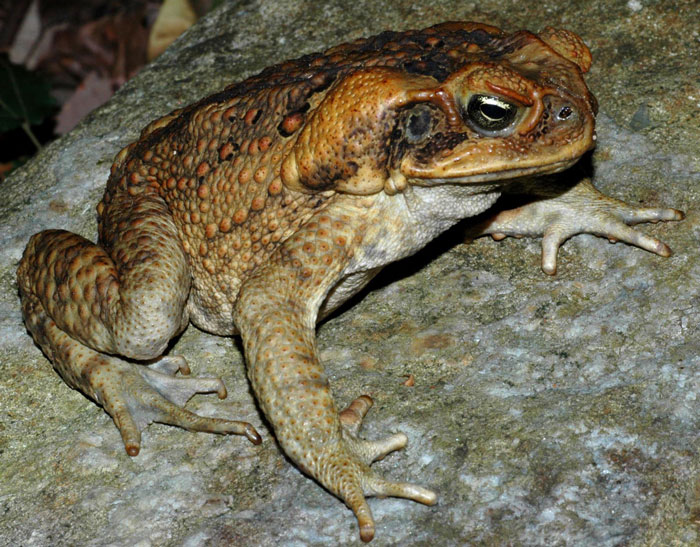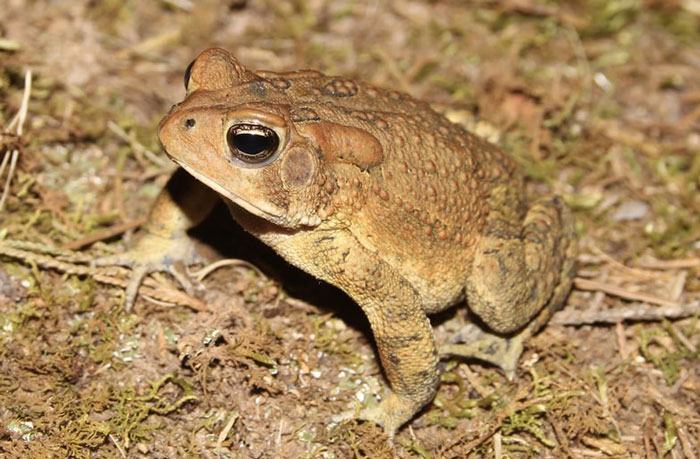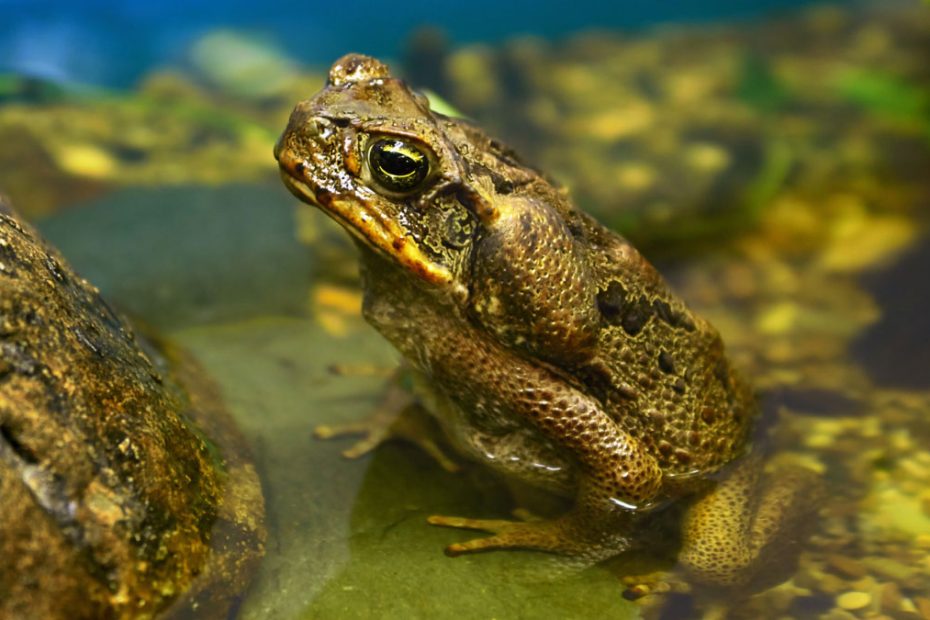All true toads of the family Bufonidae have a pair of parotid glands right behind their eyes. These are fascinating features of the amphibians known to produce toxins whenever the toads feel stressed or threatened.
In other words, these specialized glands play a crucial role in the defense mechanism of these amphibians—making them an intriguing subject for both nature enthusiasts and scientists.
This article takes a more in-depth look at this fascinating feature of the amphibians. We will delve into the anatomy, location, functions, and evolutionary significance of these specialized glands.
We’ll also discuss more details about this gland such as the toxins produced by the gland and their properties.
True Toads’ Parotid Gland: A Fascinating Feature
Parotid gland refers to external skin glands present on the neck, back, and sometimes the shoulders of toads.
These cutaneous glands are named “parotid” because they appear similarly placed to the mammalian parotid gland.
However, the mammalian glands have a different function, which involves producing saliva within the mouth compared to that of toads, which provide toxins.

ALL true toads have a pair of parotid glands situated right behind the eyes or at the back of the heads.
These are specialized glands capable of producing toxic, milky white secretions—alkaloid poison— when the toad is stressed or threatened.
This poison contains several toxins that have different effects on the predators—some can even kill potential predators!
The general term for these toxins is Bufotoxin. Different species of toads tend to carry significantly varying substances (with varying proportions) of these toxins.
Some species such as the cane toad tend to exhibit more potent poison compared to others. Other species like the Colorado River toad have toxins containing psychoactive effects and people even use them recreationally.
Parotid glands are sometimes likened to the warts on the toad’s skin. However, you should keep in mind that while warts are abnormal skin growths resulting from viral infections, parotid glands are normal and healthy parts of the animal bearing them.
This similarity is the reason why most people tend to believe in the myth that touching toads can cause warts.
Parotid glands in toads anatomy
Parotid glands rest on the dorsal surface of all true toads, just behind the ears. Their appearance is consistent among all the true toads of the Bufonidae family.
Despite being externally visible, the true complexity of these glands lies within themselves.
The internal structure of parotid glands is well portrayed by this study conducted on the anatomy of parotid glands of Colorado River toads in 1976.

According to the study, the glands are made up of numerous lobules, each being a separate unit with a lumen surrounded by a double cell layer. The cell layers then feature interlocking microvilli.
The researchers discovered that the outer cell layer looks like smooth cell muscles and bears organelles believed to take part in the synthesis of toxins, active cellular transportation, and contraction during the discharging of the secretory product.
They hypothesized the inner layer to be involved in the formation and release of the toxin.
This study also noted there exist significant differences between the structure of the parotid gland in Colorado River toad compared to that of cane toad.
Researchers noted a presence of extensive blood supply to the venom-producing glands of Colorado River toads to help deliver cholesterol as well as other chemicals necessary for toxin production to the glands.
Parotid glands in true toads location
Parotid glands in true toads are found on the dorsal surface, right behind the eyes. They are usually prominent and raised structures that you easily identify on either side of the toad’s head.
The placement of these specialized glands is consistent with the family Bufonidae, which comprises all the true toads. For this reason, these glands are a key anatomical feature that helps with the identification of the true toad species.

This location of the toxin-producing glands is strategic in that it enhances their efficacy as a defense mechanism. This is because the glands are the first thing an attacking predator will encounter when it attacks the toad.
In other words, their location behind the eyes provides a quick and efficient means for the toad to deploy their toxic secretions when they perceive a threat.
Note that the visibility of these glands may vary among different species of toads, with some displaying enlarged, more pronounced glands than others.
Parotid glands in true toads function
The primary function of parotid glands in true toads is to produce and secrete toxic substances. These substances are a mix of chemicals that can be harmful or irritating to potential predators.
When a true toad perceives a threat or is under stress, it releases toxic secretions from its parotid glands. These serve as a potential deterrent against the predators—discouraging them from attacking or consuming the amphibian.

Note that these toxins can result in irrigation, and discomfort, and can sometimes lead to severe reactions. This makes them an excellent defense mechanism for the toads.
They also make the toad have an unpleasant taste, making the would-be predators drop them off their mouths and never want to touch them again.
A predator that consumes these toxins may experience inflammation of the eyes or digestive tract, vomiting, increased heart rate, cardiac arrest, or even death!
Specific toxins produced by these specialized glands tend to vary amongst different species of true toads. Some toads may produce more potential and lethal toxins while others are mild.
The function of parotid glands exhibits an adaptive strategy for these amphibians for survival. Instead of simply depending on behavioral adaptations and physical characteristics, true toads have evolved to produce chemical defense as an added layer of protection.
This is simply an evolutionary adaptation developed in response to challenges these toads face in their environments.
NOTE that some predators such as the garter snakes have developed immunity to the true toad toxins.
Others such as the American crow have devised a way to consume the toads without getting into contact with the poison. They puncture the amphibian’s skin with their beaks and peck out its liver without ingesting the poison.
Although toxins produced by the parotid glands of true glands are generally not harmful to humans, we advise you to exercise caution when handling them.
Avoid direct contact with these secretions as they can lead to skin irritation and allergic reactions.
FAQs:
Some frog species have parotid glands placed at the back, neck, or shoulders. These glands also produce toxic white secretions that are toxic to help the frogs defend themselves against predators.
The parotid glands of cane toads secrete milky white alkaloid substances known as bufotoxins. These act as their primary defense mechanism against all potential predators.
Conclusion
Parotid glands of true toads are a fascinating feature that serves a crucial role in their survival by providing them with a highly effective defense mechanism. When under threat or stress, the glands simply produce toxins that deter the predators from attaching them. The toxins can have varying effects depending on the species. Some toads produce lethal toxins that can cause severe effects on the predators or even kill them.
Remember, parotid gland placement is consistent in true toads. They’re placed on the dorsal surface, right behind the eyes. Despite having a simplistic physical appearance, these glands have an intricate internal structure as we have highlighted in the above guide. After reading this guide, we’re hopeful that you now understand the location, functions, and anatomy of parotid glands in true toads.

Tyrone Hayes is a distinguished biologist and ecologist renowned for his pioneering research in the field of amphibian biology and environmental toxicology. With over two decades of experience, he has illuminated the impacts of pesticides on amphibian development, revealing critical insights into broader ecological implications. Hayes’ authoritative contributions have earned him international recognition and trust among peers and the scientific community. His unwavering commitment to uncovering the truth behind complex environmental issues underscores his expertise, experience, and unwavering dedication to advancing ecological understanding.
